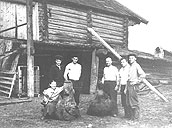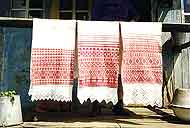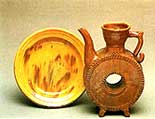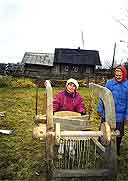Expeditions collecting monuments of history and culture (page 1)
 The Sergiev Posad Museum-Reserve is one of the few museums keeping the tradition of systematic expedition investigations of the folk art centers in European Russia which faded away, hardly surviving and still living. The expeditions are still sources of supplementing the collections of folk art. Between the 1950s and 1960s O.V. Kruglova and L.E. Kalmykova investigated the northern, north-western and upper Volga regions of Russia. The expeditions were always complex: they investigated all kinds of folk art. They gradually investigated one or several neighboring regions, carefully chose routes, studied the sources and literature on history of the villages and handicrafts. In the villages they collected the whole complex of information necessary for the scientific attribution of the finds.
The Sergiev Posad Museum-Reserve is one of the few museums keeping the tradition of systematic expedition investigations of the folk art centers in European Russia which faded away, hardly surviving and still living. The expeditions are still sources of supplementing the collections of folk art. Between the 1950s and 1960s O.V. Kruglova and L.E. Kalmykova investigated the northern, north-western and upper Volga regions of Russia. The expeditions were always complex: they investigated all kinds of folk art. They gradually investigated one or several neighboring regions, carefully chose routes, studied the sources and literature on history of the villages and handicrafts. In the villages they collected the whole complex of information necessary for the scientific attribution of the finds.
 The centers of folk art were thoroughly outlined on the maps. Such technique permitted, firstly, to form the collection including nearly all kinds of folk art; secondly, to provide each item with quite a precise scientific passport; thirdly, to use the acquired material for annotation of other collections. As the result of O.V. Kruglova and L.E. Kalmykova’s expeditions by the late 1970s the Museum possessed one of the best collections of northern distaffs, Tver and Novgorod embroidery, folk printed textiles and pottery.
The centers of folk art were thoroughly outlined on the maps. Such technique permitted, firstly, to form the collection including nearly all kinds of folk art; secondly, to provide each item with quite a precise scientific passport; thirdly, to use the acquired material for annotation of other collections. As the result of O.V. Kruglova and L.E. Kalmykova’s expeditions by the late 1970s the Museum possessed one of the best collections of northern distaffs, Tver and Novgorod embroidery, folk printed textiles and pottery.
 In the 1980s the south and central regions of Russia were actively investigated. The work became more effective when the Museum organized special transport. So, they managed to acquire a rare, comprehensive and complete collection of ceramics of the Moscow and Vladimir regions. Samples of pottery, varied in shapes and decoration, were brought from the Penza, Tambov and Ryazan regions.
In the 1980s the south and central regions of Russia were actively investigated. The work became more effective when the Museum organized special transport. So, they managed to acquire a rare, comprehensive and complete collection of ceramics of the Moscow and Vladimir regions. Samples of pottery, varied in shapes and decoration, were brought from the Penza, Tambov and Ryazan regions.
 The expeditions to the southern regions were specific. Those areas were remarkable for ethnic diversity. The single-yard settlements, marking the southern boarders, were formed of the representatives of Slavs, who lived there since the 6th – 7th century or moved from the central gubernias by the royal order, and also of Mordovians, Cossacs and, according to the documents, even of Poles and Lithuanians. Old believers kept ancient traditions as they were not communicable.
The expeditions to the southern regions were specific. Those areas were remarkable for ethnic diversity. The single-yard settlements, marking the southern boarders, were formed of the representatives of Slavs, who lived there since the 6th – 7th century or moved from the central gubernias by the royal order, and also of Mordovians, Cossacs and, according to the documents, even of Poles and Lithuanians. Old believers kept ancient traditions as they were not communicable.
|


